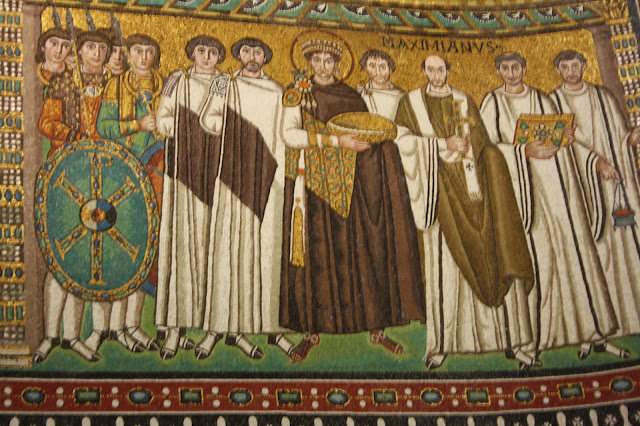I know precisely when I first found out about the wonderful Late Roman mosaics in Ravenna. It must have been mid November, 1973, when Dr Roger Ling wrapped up his introductory module on Classical Art to the semi-interested, callow first years on Manchester University's History of Art degree. The following year, when one of my specialist subjects was Early Medieval Art, Dr Alexander began his course with a consideration of the mixture of Classical and Christian elements within the mosaics. That these mosaics, and the buildings in which they are situated were of equal interest to both a classicist and a medievalist is testament to their importance as rare artifacts dating from the time of transition from the Roman World to Christendom, when church replaced empire as a unifying force in an otherwise chaotic and war-torn Europe. I suppose that the fact that this grey-hair was drawn to visit Ravenna on the basis of what two academics said more than four decades ago is a testament to their inspirational teaching. So, a belated thanks!
The buildings housing the mosaics are over 1500 years old. The earliest - the Mausoleum of Galla Placadia and the Battisero Neoniano date from around AD 430, just two decades after the fall of Rome to the Visigoths. Indeed, Galla Placadia was the daughter of the last Emperor to rule from Rome. She was carried off by the conquering Visigoth leader, but later escaped to Ravenna, which by that time had become the capital of the Western Roman Empire.
 |
| Battisero Neoniano was built originally as a Roman Bath House, and converted to a Christian Baptistery in AD 434 |
 |
| Sumptuous golds and blues |
 |
| Classically derived figure style mixed with linear 'Byzantine' drapery |
 |
| The decorative frames mix geometric and natural forms |
 |
| The central dome was decorated in the Baroque style - sometime in the late 17th century by the look of it. |
 |
| Emperor Justinian and his courtiers |
 |
| Empress Theodora is notorious for having risen from humble beginnings - as a performer in live sex shows. |
 |
| The linking of New Testament events with Old Testament prophets was to become a trademark of later, Medieval Christian iconography. |
 |
| Here, St Mark is shown next to Isiaih |
 |
| An 'unbearded,' Christ - typical of early representations in the West. |
Perhaps it is a poem by Yeats that captures best how these images create 'the artifice of eternity'. I have to post it. If you know the poem, you will love to read it again; if you don't, then you should, -because it's great.
Sailing To Byzantium
I
That is no country for old men. The young
In one another's arms, birds in the trees
---Those dying generations---at their song,
The salmon-falls, the mackerel-crowded seas,
Fish, flesh, or fowl commend all summer long
Whatever is begotten, born, and dies.
Caught in that sensual music all neglect
Monuments of unaging intellect.
II
An aged man is but a paltry thing,
A tattered coat upon a stick, unless
Soul clap its hands and sing, and louder sing
For every tatter in its mortal dress,
Nor is there singing school but studying
Monuments of its own magnificence;
And therefore I have sailed the seas and come
To the holy city of Byzantium.
III
O sages standing in God's holy fire
As in the gold mosaic of a wall,
Come from the holy fire, perne in a gyre,
And be the singing-masters of my soul.
Consume my heart away; sick with desire
And fastened to a dying animal
It knows not what it is; and gather me
Into the artifice of eternity.
IV
Once out of nature I shall never take
My bodily form from any natural thing,
But such a form as Grecian goldsmiths make
Of hammered gold and gold enamelling
To keep a drowsy Emperor awake;
Or set upon a golden bough to sing
To lords and ladies of Byzantium
Of what is past, or passing, or to come.
Sent from my iPhone




No comments:
Post a Comment